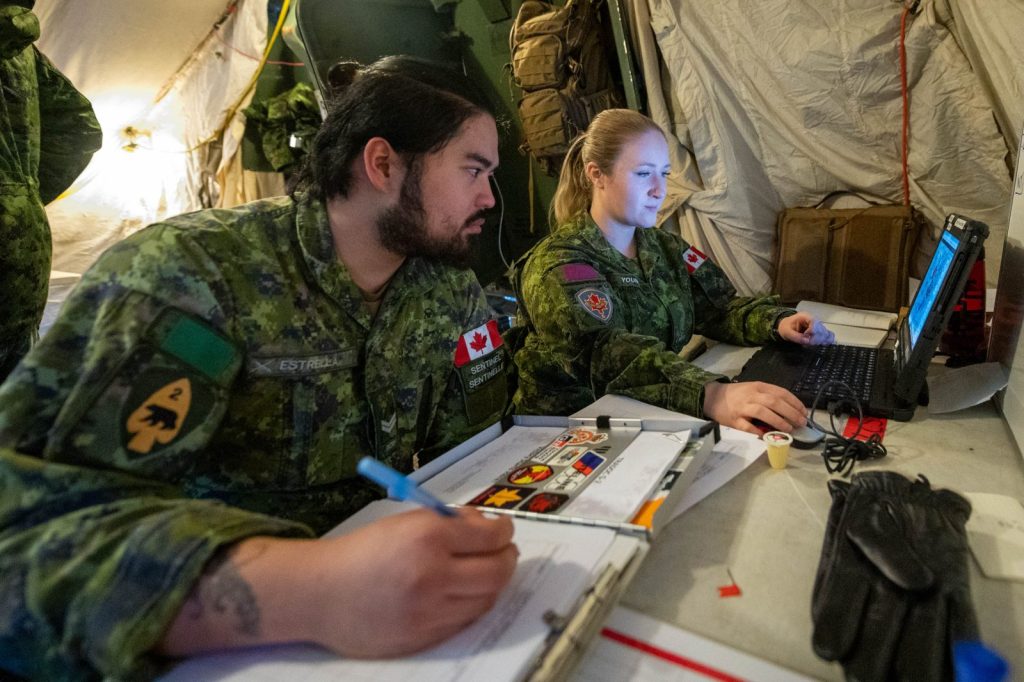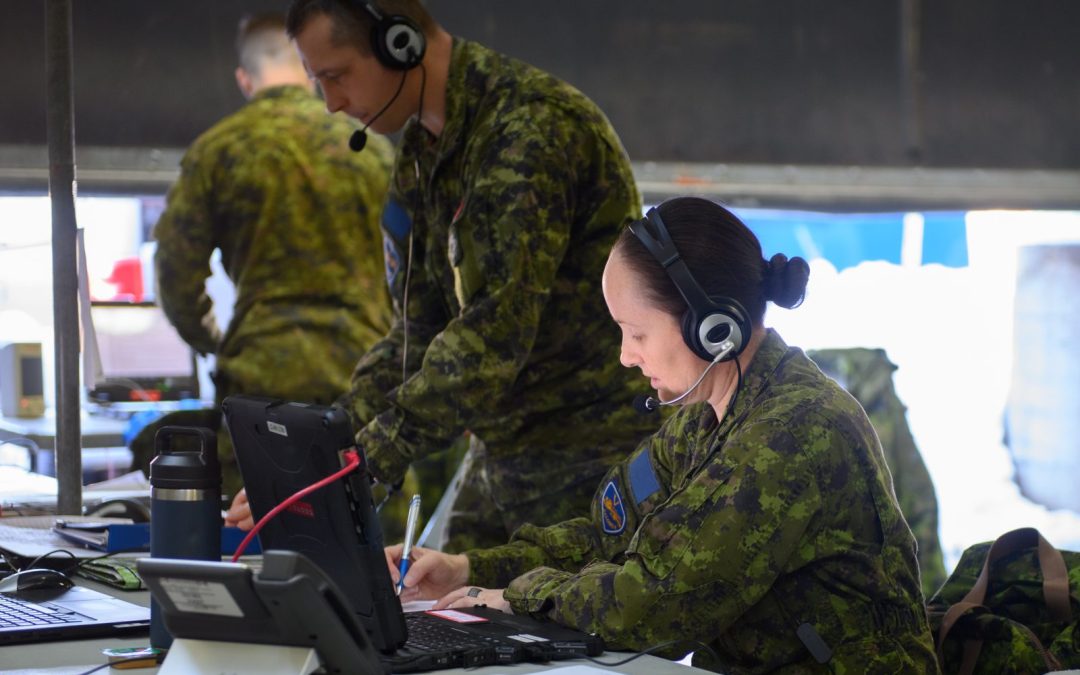by Chris Thatcher
Over the past three years, 6 Canadian Combat Support Brigade (6 CCSB) has conducted an experiment to understand how best to integrate its myriad of enablers into a manoeuvre brigade headquarters.
As the mechanized brigade ramps up its training during the build phase of the Army’s Managed Readiness Plan, a Combat Support Group (CSG) has trialed different ideas for providing the brigade commander with improved access to ISTAR (intelligence, surveillance, target acquisition and reconnaissance) sensors, electronic warfare (EW), civil-military cooperation (CIMIC), psychological operations (PsyOps), and other capabilities.
Previously, a commander might have had to push multiple buttons, including reaching up to a division headquarters, to tap the expertise of an all-source intelligence cell, a small uncrewed aerial system (SUAS), medium range radar (MRR), specialty engineers, geomatics intelligence, or influence activities.
Through the CSG experiment, 6 CCSB has used the computer-assisted Unified Resolve series of exercises and Maple Resolve, a confirmation exercise of Army readiness, to test ways to better integrate those capabilities into a manoeuvre brigade headquarters and make them accessible to a commander.
Where previously many of those might have been attached to the brigade with their own points of contact — and contributed tangentially to the manoeuvre brigade planning — 6 CCSB now sought to make that expertise available through a single CSG command team and coordination centre.
For the third and final iteration of the CSG experiment, Lieutenant-Colonel Natasha Skidmore, the commanding officer of 4th Artillery Regiment (General Support), decided to stress the concept a little further, expanding the scope of the CSG team and integrating their experience directly into the brigade planning cell.
As the commanding officer of the CSG on Ex Unified Resolve 2023 (UR23) in February, she opted to “try something a little bit different.” Since the Army modernization strategy puts a premium on being innovative and adaptable, she placed enablers such as the ISTAR coordination centre, EW coordination centre, influence activities and intelligence functions among the operations staff.
“We wanted to be more integral and really integrate ourselves,” she explained, “so instead of having them located in the CSG headquarters, we decided to have more direct representation on the current ops floor than the past two iterations. In past iterations, [the CSG] filled a sense function. This time, we took a little more responsibility and filled their ISTAR function.”
Not only did that embed ISTAR and other specialists in the brigade planning cell, it also reduced the number of liaison staff between the brigade and the CSG headquarters for the exercise, shrinking the CSG footprint considerably.
“In the past, one representative would [go back and forth] and we would build the plan at CSG headquarters,” she said. “This time, we built our plan in the G5 [planning] shop with the G5. When we had to move assets, it was done on the current brigade ops floor, not back at the CSG. So, less liaison and more empowered decision-makers there that could execute plans.”
In addition, the CSG’s intelligence capabilities were integrated more closely than previously with other military intelligence functions in the CSG headquarters, reinforcing the intelligence capability of brigade operations, Skidmore said. Beyond helping answer the intelligence questions for the manoeuvre brigade, CSG was able to provide detailed intelligence related to its own specialist capabilities.
“How is the enemy going to target the SUAS? What exact air defence systems will they use to shoot it down? We were able to provide tailored intelligence for each of our capabilities, whether EW or the CIMIC and PsyOps teams on the ground,” she explained. “I thought we had a great interplay between the deep intelligence thinking and then the close fight for information.”

Members of 2 Canadian Mechanized Brigade Group Headquarters and Signal Squadron during Ex Unified Resolve in a decentralized Command Post environment. Photo: Cpl Aimee Rintijema
Unified Resolve’s primary training audience, 5 Canadian Mechanized Brigade Group (5 CMBG), placed a particular emphasis on integrating its own informational capabilities and staff with those of the CSG. To ensure efforts and activities were aligned, the CSG physically positioned its PsyOps and CIMIC staff side-by-side with the brigade headquarters’ integral G9 team, who focused on many of the same issues. The result was seamless coordination and noticeable improvements compared to the past two iterations of the exercise.
“That was a huge win,” she said. “Often, we don’t bring everybody to the fight. But when we brought in that [PsyOps and CIMIC] team, they were able to play realistically and challenge assumptions from different angles.”
Skidmore, an artillery officer who has spent much of her career on the gun line and as a forward observer and joint terminal attack controller, also opted to blend the personnel of the Surveillance Target Acquisition Coordination Centre among 4th Artillery (GS) and close support artillery. The unusual step allowed junior members of both teams to learn and share information on long range sensors and close support artillery. “In the spirit of being innovative and adaptable, I thought it was a great professional development opportunity for our team,” she said.
If the original intent of the CSG experiment was to provide a brigade commander with a single button to push to deliver the effects of 6 CCSB’s enablers, the commander of 5 CMBG, Colonel Marie-Christine Harvey, still had “one-stop shopping” to close her sensor to shooter link, Skidmore noted. But by placing CSG expertise directly on the current ops floor and within the plans team, she ensured the right people were in position to provide advice.
“Sometimes our specialist enablers are under-ranked,” she observed. “The most knowledgeable person on lightweight counter-mortar radars is often a master bombardier or a sergeant, and sometimes in a headquarters full of captains and majors, they are not heard in the way they should be. But when we specifically designate a team to look after these enablers, despite their ranks, they are heard.”
The CSG concept was tested once again in a scenario within the Decisive Action Training Environment. Set in Eastern Europe, the Canadian brigade fought alongside a Latvian brigade, driving back an invading force to the border. The scenario included a mobile defence, reconstitution, and then a counterattack to push the enemy back across the previously established international boundary. The congested ground and airspace provided a challenging mission for the brigade, and a constant test for CSG’s enablers, especially its intelligence capacity and its PsyOps and CIMIC abilities in highly populated areas.
“We had a good balance of emphasizing the complexity at some of the stages of battle that we don’t often practice,” Skidmore said.
With the experiment now complete, the Army will sift through the additional information from the third trial to finalize a construct that can be bolted onto a brigade. The first deployment of that could be in Latvia, where the Army is preparing to augment its multinational battle group with additional resources to help scale it to brigade strength.
“We definitely saw the value of the experiment. It is absolutely influencing the future of how we employ enablers at the brigade level,” Skidmore said. “I don’t know what the end conclusion will be for the CSG, but I think the experiment does give us a template … for how to attach some of these divisional and higher-level enablers at the brigade level.”
One option could be an ISR company headquarters, led by a command team at the lieutenant-colonel or major level. “That reflects the doctrine of many of our allies and the direction they are going in,” she noted.
The composition of 6 CCSB enablers in such a company will be dependent on the dynamics of the mission, but the experiment and latest trial of “unique lines of command” and a different approach to integration “allowed us to exercise our own adaptability and flexibility … and to draw a bunch of conclusions about what does and does not work, and why,” she said.
The 6th Brigade was formed in 2018, unifying the capabilities of the Canadian Army Intelligence Regiment, 4th Artillery Regiment (GS), 4 Engineer Support Regiment, 21 Electronic Warfare Regiment, and Influence Activities Task Force under one command. Because they are not co-located and don’t often train as a brigade, the CSG experiment has been instrumental in building a common understanding and identity.
“I think this whole construct challenged how we connect and how we integrate,” said Skidmore. “For all at CCSB, we learned exponentially what our partners do. We know we are a little bit alike, but we are also very different. This was a greater opportunity to understand and learn from each other.”
Heavily groomed in field artillery, she was initially reluctant to transfer to the 4th Artillery Regiment (GS). But after commanding a battery there, she “fell in love” with one of the more dynamic units in the Army, which provides MRR, SUAS, and Air Space Coordination Centres, and could soon be the home of Very-Short-Range Air Defence Systems (VSHORAD) —currently being acquired as an urgent operation requirement for the mission in Latvia — and eventually Ground-Based Air Defence. “We are shaping the institution and maturing new Canadian capabilities,” she observed.
ISTAR was not an area of expertise, she admitted, so she had to dig into the doctrine before assuming command of the CSG. So, she also asked the units to produce presentations for all 6 CCSB members participating in Ex Unified Resolve, to expose the team to the brigade’s specialities. “It was great teambuilding for these folks who provide niche capabilities. I’ve never commanded such a diverse team of specialists. This will be a career highlight for me, for sure.”

